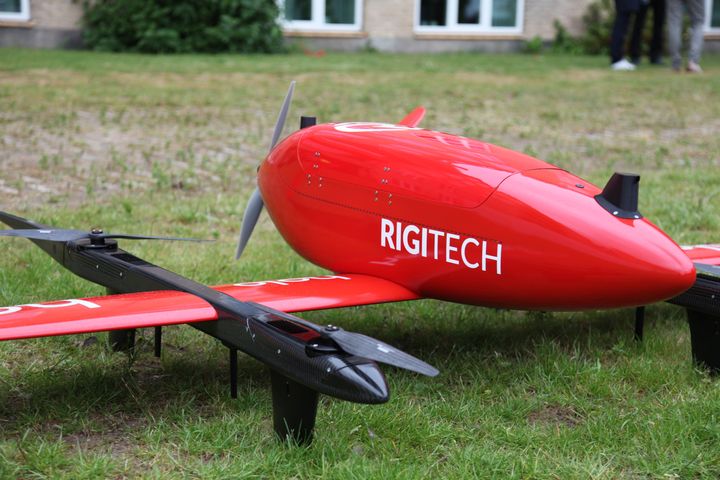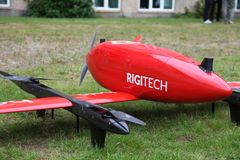Danish health drones are taking off: Towards faster and better treatment

Today, if you live on one of Denmark's smaller islands and have a blood sample taken, the sample must be transported by ferry and car for analysis at the hospital's laboratory. In future, the distance will be shorter, because now the way has been paved for the blood sample to be sent by drone directly and immediately to the laboratory.
This will become the reality Monday 30 May, when Danish Minister of Transport, Trine Bramsen, stands by in Svendborg to send the first Danish health drone off via a radio connection.
After years of planning and testing, the partnership behind the health drones is ready to demonstrate the first flights across the water. A route of 50 kilometers, taking place at an altitude of 80 meters.
The drone will fly from OUH Svendborg Hospital to Ærø. The first version of the drone can bring blood samples from the small island community to the laboratory. In the longer term, the plan is for medicines and equipment to be transported between hospitals, laboratories, medical centers, nursing homes and home care. In line with the government's new health care reform, the scheme can be extended to smaller islands or areas that are far from a hospital, thus bringing the health service out to the patient.
- There is no doubt that with the entry of health drones into the health care system, we are entering a new era, says project manager from the University of Southern Denmark (SDU), Kjeld Jensen.
What are the health drones?
The HealthDrone project will integrate drones into the Danish healthcare system. Behind the project is a partnership consisting of OUH, Falck, Holo, Unifly, Scandinavian Avionics and SDU. HealthDrone is in the process of developing and testing drones for transporting blood samples and medicine between Ærø, Svendborg and Odense.
The drones have already completed successful test flights from Ærø to Langeland but will pass a new milestone when the full distance from Svendborg to Ærø is completed. In short: it works!
- It is exceptional in a European context that we fly with the drones without shutting down the airspace. Together with Naviair, Unifly and the Danish Transport Authority, we at SDU have developed a method for tracking helicopters and aircraft so that we can manoeuvre around them. The air traffic control at Naviair can see on their screens when a drone flight is in progress and will act if e.g. a rescue helicopter needs the airspace. We have paved the way for this to be possible, says Kjeld Jensen.
We can be ready tomorrow!
One of the commercial players in the project is the mobility company Holo, which together with Falck is the operator of the flights. According to the CEO of Holo, Christian Bering Pedersen, the company is in principle ready to offer the service immediately.
- With this project, some barriers to drone flying have been removed, which means that we can now offer a transport service via drone for many different purposes. The project has paved the way for freight via drones, says Christian Bering Pedersen, who is also chairman of the steering committee behind the Healthdrone project.
The drones have the potential to ensure faster and better treatment, says Bjarne Dahler-Eriksen, who is medical director at OUH.
- It is a major focus area for us to spare patients - especially the particularly vulnerable - from spending time on transport and waiting time, so that they can instead have samples taken at home or near the home. Today we are dependent on the fixed times for car and ferry transport, but the health drones make it possible to get samples analysed in a much shorter time, so in the future we can ensure correct treatment faster for the benefit of both the health service, but of course first and foremost for patients, he says.
Time is often a crucial factor, and here too drones may play a vital role in the future. Be it in connection with accidents, where rapid access to blood can mean the difference between life and death, but also in connection with infections, where faster responses provide better treatment. Another future option is to deliver medicine directly to the patients so that they do not have to go and pick up expensive special medicine at the hospital.
Facts about HealthDrone
HealthDrone is a three-year innovation project supported by the Innovation Fund. The goal is to develop and test health drones for transport of patient samples, medicine and medical equipment between hospital wards, medical centers, and home care.
After several years of thorough experiments and tests with health drones at the UAS Denmark Testcenter at HCA Airport, at OUH and by flights internally on Ærø, the drones are now ready to do test flights in air corridors between Ærø and Svendborg, and Svendborg and Odense.
Current transports are limited by fixed routes and departures, and ferry services taking 75 minutes between Ærø and Svendborg. Therefore, drone transport will contribute significantly to both a faster and not least a more flexible transport solution.
When the health drones are ready, they will improve logistics in the healthcare sector and thus mean faster and better treatment for the patients. The drones will make it possible to do more examinations at the doctor's or at home that previously required visits to the hospital.
Project partners: SDU, Falck, Holo, Odense University Hospital, Unifly and Scandinavian Avionics.
Total budget: DKK 30,615,297, of which DKK 14,107,438 from the Innovation Fund.
Project period: 2019 - 30 September 2022
Keywords
Contacts
Jane Thoning CallesenHead of TEK CommunicationSyddansk Universitet / The University of Southern Denmark
Faculty of Engineering at the University of Southern Denmark
Images

Links
About Syddansk Universitet
Subscribe to releases from Syddansk Universitet
Subscribe to all the latest releases from Syddansk Universitet by registering your e-mail address below. You can unsubscribe at any time.
Latest releases from Syddansk Universitet
Det kræver mod, når TV2-regionernes fremtid skal afgøres2.12.2025 10:32:12 CET | Pressemeddelelse
Den offentlige demokratiske samtale står midt i en brydningstid, hvor medieudviklingen fundamentalt ændrer forudsætningerne for, hvordan journalistik produceres, formidles og forbruges.
Dokumenteret effekt af idrætsindsats i skolen28.11.2025 09:48:41 CET | Pressemeddelelse
Fit First-programmet forbedrer skoleelevers fysiske form, kropssammensætning og sundhedsprofil – også hos 10-15-årige piger og drenge.
Nyt forskningsprojekt skal bringe humanoide robotter til Danmark26.11.2025 08:48:20 CET | Pressemeddelelse
Forskere fra Syddansk Universitet (SDU) vil sammen med Novo Nordisk, Harting og flere andre partnere udvikle en menneskelignende robot, der kan overtage ensformige, slidsomme og sundhedsfarlige opgaver i industrien.
Flere nybagte mødre bruger vægttabsmedicin efter fødslen24.11.2025 20:13:33 CET | Pressemeddelelse
Nyt dansk studie fra Syddansk Universitet kortlægger udviklingen i brugen af GLP-1-medicin blandt kvinder i månederne efter fødslen.
Oprettede falsk profil som 13-årig på TikTok så masser af ulovlige reklamer20.11.2025 09:25:20 CET | Pressemeddelelse
Forskere oprettede en falsk profil som en 13-årig pige og blev præsenteret for videoer med tobaks- og nikotinprodukter, selvom det er i strid med både danske regler og TikToks egne guidelines.
In our pressroom you can read all our latest releases, find our press contacts, images, documents and other relevant information about us.
Visit our pressroom
